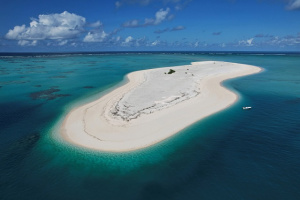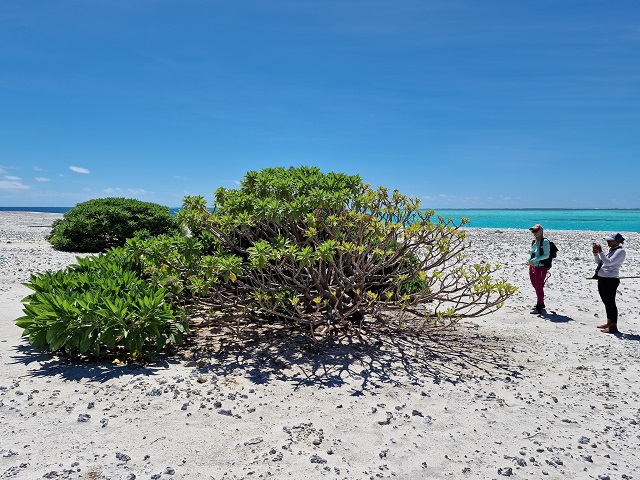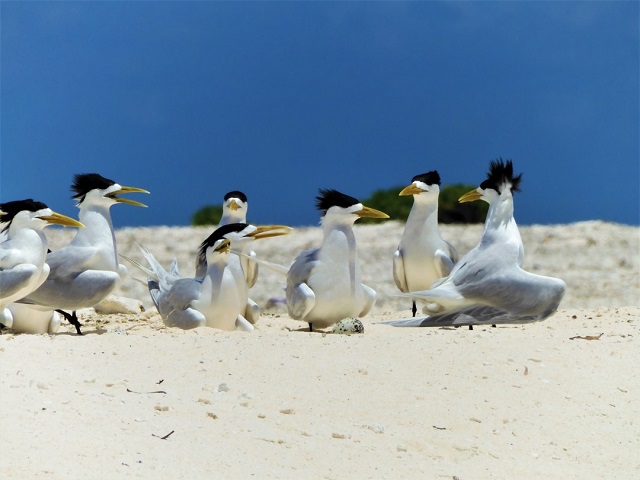New island next to Seychelles' Farquhar Atoll is getting larger
General |Author: Juliette Dine Edited By: Betymie Bonnelame | August 27, 2023, Sunday @ 09:40| 22695 views
The new island has been named Derrick's Sandbank by the Islands Development Company. (William McNeely, Island Conservation Society)
(Seychelles News Agency) - A new island formed around the Farquhar Atoll, which emerged after tropical cyclone Fantala hit the island in mid-April 2016, is getting bigger according to the Island Conservation Society (ICS).
The new island has been named Derrick's Sandbank by the Islands Development Company (IDC), a state-owned company, after the carcass of a cargo crane, referred to as a "derrick", that came from a wrecked ship nearby.
The sandbank, which is located about 16km southwest from the IDC settlement on North Island of Farquhar and about 6 km west from Goëlettes, was 0.3 hectares in 2015 and is now 7.8 hectares from the latest data collected in 2023.
The ICS, which set up a conservation centre on Farquhar in 2014, routinely record the dimensions of notable sandbanks using GPS devices, allowing them to track the stages of this new formation. The height of each plant and tree is measured manually or using a smartphone app and the flowering stage is recorded.
 |
| The height of each plant and tree is measured manually. (William McNeely, Island Conservation Society) Photo License: All Rights Reserved |
Gregory Berke, the director for conservation and science of ICS, said that the information that is being collected will allow the organisation to document the progression of the island's formation.
"Due to climate change, the rate of coastal erosion and loss of land due to rising sea levels is increasing. Being able to document the formation of a new island could provide ICS with valuable insights that can be beneficial when addressing climate change issues and mitigation adaptation measures," he explained.
In late 2019, ICS observed that the sandbank had gained elevation beyond that of the high-water mark, giving it dry land. Its emergence above water was certified when vegetation quickly began colonising, with the coastal shrub Bwataba acting as the predominant pioneer species and others such as the tree heliotrope with a few coconut sprouts.
Over a year later, the pioneer plants, which were at the seedling stage in December 2019, are now over a metre tall and 2-3 metres wide.
The new land, absent of predators such as rats and cats, has attracted breeding colonies of seabirds, including greater crested terns and black-naped terns. Roosting birds also benefitted, including less than 500 Saunders terns.
 |
| The greater crested terns are one of the breeding colonies of seabirds on the island. (William McNeely, Island Conservation Society) Photo License: All Rights Reserved |
Berke said that "the absence of rats could provide useful insight into the effects of how ground-nesting seabirds react to the presence of rat-free habitats in the selection of potential new nesting sites."
According to ICS, the presence of animal life will help increase the sands' fertility, thus encouraging the vegetation to develop. The roots of plants will then play a role in solidifying the structure by binding loose substrates together.
This combination of animals and plants, along with several other processes, can help create the foundation of a permanent structure with resistance to erosion, ultimately leading to the creation of an island.
"However, it is hard to say at that stage if the island will remain permanent. In the future, it is likely that more and more plants will grow making Bancs Derik very similar to Bancs de Sable - which is only about 50 years old and probably started the same way Derik did," said William McNeely, the conservation officer working on Farquhar Atoll.
However, ICS notes that extreme climate could be a menace and there is the possibility that the island might eventually disappear.
Back
